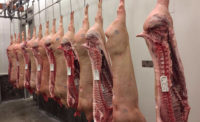What’s inside the package has changed tremendously, however, in the past couple years (or will change soon), as consumers demand less sodium, more natural ingredients and marinated enhancements. How are processors handling the delicate balance between consumer requests and marketplace reality?
“There are many continuous improvements by equipment and materials suppliers to improve efficiency [and] safety, and lower costs,” says Andrew Milkowski, Ph.D., adjunct professor, animal sciences, muscle biology laboratory, University of Wisconsin-Madison.
As with all products, there is a search for novelty in forms and flavors to introduce popular new products. The NCBA study noted, for one, that there has been an increase in case-ready product; consumer product information such as nutritional claims, cooking information, country-of-origin and bilingual labels; and natural claims.
So far, rotisserie pot roasts and roast beef, which would utilize whole-muscle product, haven’t made it back to grocery stores, but there are always rumblings of new product development on the horizon, says Lynn Knipe, Ph.D., the extension processed meats specialist and associate professor in food science and technology, and animal sciences at Ohio State University, Columbus, Ohio.
“I have always thought that this type of product needed to be developed to compete with all of the rotisserie chickens in supermarket delis,” says Knipe. “Probably 10 years ago or longer, Sara Lee tried a rotisserie pork roast, which was excellent, but apparently too expensive to compete with the chickens.”
Latin flavors are also being incorporated into meat products as the nation has more families of Hispanic origin, says Josh Herring, Ph.D., assistant professor, department of food & animal sciences, Alabama A&M University, in Normal, Ala.
“More functional foods — containing antioxidant ingredients — are being and will continue to be introduced to retain meat quality, as well as add to the health of those consuming those food products,” he notes.
Processors have faced challenges over addressing current concerns about sodium content based on the 2010 Dietary Guidelines for Americans targets, says Milkowski.
In addition, the recently passed Healthy, Hunger-Free Kids Act, which re-authorizes the Child Nutrition Act, sets improved nutrition standards for school meals, such as gradually reducing the amount of sodium in meals over 10 years, with the eventual goal of reducing sodium by more than half.
“Reducing sodium while maintaining product quality and safety is a definite technical challenge,” says Milkowski.
Less sodium, more natural ingredients
The drive to reduce sodium and use more natural ingredients is challenging for processors due to the nature of how whole-muscle products are created today.
According to Knipe, most whole-muscle products are made using a process called tumbling, massaging or mixing. Either way, processors are applying a physical treatment that won’t cause damage to the meat.
Salt and phosphates actually help whole-muscle products retain the juiciness, flavor and yield that consumers expect.
Processors have traditionally kept salt and phosphate levels at 1 percent to 1.5 percent, but are now attempting to hit 0.5 percent to 0.7 percent to meet consumer demands for low-salt food items, says Christine Alvarado, Ph.D., assistant professor, poultry processing, animal and food sciences, Texas Tech University, in Lubbock, Texas.
“Phosphate-free ingredients use other ingredients that can carry a natural label. These ingredients are just starting to come out and become more popular for niche markets,” she says.
Unknown to most consumers, explains Alvarado, meat actually contains a lot of water. Most of this water is “free” and can be lost during cooking, pressure or stress, and the rest of the water is immobilized and more tightly bound.
Phosphates have charges that attach to meat protein and this immobilized water in order to retain and improve juiciness.
By cutting back phosphates or using natural ingredients that don’t contain phosphates or that don’t bind as tightly to water, processors will have to find another way to provide a quality product.
“From the industry perspective, these new low-salt and natural products can offer consumers more alternatives when purchasing meat products,” she says.
Phosphates are certainly a relatively cost-effective solution for processors since they increase marinade retention.
“If [phosphates] are taken out of the equation, ingredient suppliers and processors have been coming up with different mixes of functional ingredients to increase yield and functionality,” says Alvarado.
Controlling yield loss (and food safety)
It’s unknown if tampering with salt and phosphate levels will affect whole-muscle products’ bacterial loads and safety, and in what way. Whenever there is an increase in water activity (free water), there is a chance for bacteria to grow, which can decrease shelf life and potentially cause food-safety problems.
If the free water is bound by functional ingredients, however, then food safety and shelf life are improved.
“The question of whether low-salt and natural marinades affect food safety is difficult since processors use many food-safety interventions,” says Alvarado.
There is a reason the American Meat Institute Foundation still regards E. coli as a major threat to food safety, especially from fresh beef, says Herring.
“Pathogen control will always be an issue in whole-muscle cuts as producers will always want to increase yield, which continues to be via massaging, injection and tumbling — which are ways to increase contamination and internalization of external pathogens,” says Herring.
Portion-controlled products, such as nuggets and battered pieces or products, can use leftover meat, which increases food-safety concerns, as well.
Another constant challenge for whole-muscle processors is iridescence, or rainbow of colors, that appears on the surfaces of some whole-muscle products, and is particularly noticeable on beef.
“These colors cause concern with consumers, because the most common colors are green, yellow, etc., which you don’t expect in sliced roast beef or ham,” says Knipe.
There appear to be many potential causes for this phenomenon, but there are no sure solutions to this problem.
“Iridescence appears to increase with lower pH, when products are injected to higher levels, when whole-muscle products are sliced with sharp blades, and when sliced perpendicular to the muscle fiber orientation,” he says.
Pre-portioned and pre-cooked whole-muscle products also face challenges with yield levels. Cooking causes moisture loss, which can lead to a reduced yield for processors. When product is par-fried or even cooked at the plant, yield loss can be significant, says Alvarado.
To retain moisture, processors may use high moisture or steam to cook the product. However, this method of cooking often prevents browning from occurring, which can lead to a decrease in consumer acceptance. In order to create a char-grilled or browned appearance, processors add a browning step with some new technologies.
“There is more browning, char-grilling equipment today for color development, which prevents yield loss and has an added benefit of increased juiciness and better color for consumer appearance,” says Alvarado.
Weighing health concerns
In the next few years, whole-muscle processors will have to balance bacterial loads and safety concerns with making more green or “clean label” products, which are perceived as safer and more healthy by the general public, notes Herring.
“As soccer moms continue to desire healthier foods for their children, the sodium issue will persist, as well as fat concerns — saturation, hydrogenation, etc.,” he says.
However, these altered products will not come cheap, and cost may skew product selection.
“Many consumers will skip the marinated whole-muscle cuts as the sodium levels are too high or the seasoning may be too new to risk the purchase price, as the whole-muscle cut will cost more and the size will drive up the unit price,” says Herring.
Finally, fresh seafood, though not generally a major focus when discussing whole-muscle foods, also will face increased scrutiny as the oil spill in the Gulf of Mexico continues to alter the safety and security of seafood from that region, says Herring.









Report Abusive Comment